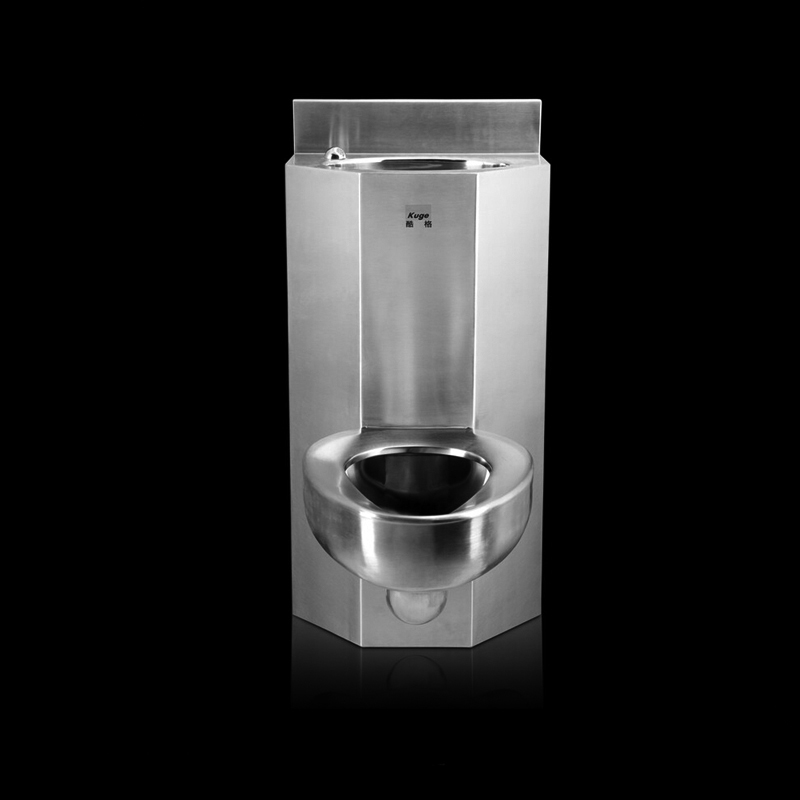The Strength of Stainless Steel
One of the primary considerations in designing prison toilets is durability. These toilets are typically made from stainless steel, a material known for its strength and resistance to vandalism. The robustness of stainless steel makes it an ideal choice for environments that may experience rough use or intentional damage. In correctional facilities, where the potential for vandalism is high, this material stands up to the challenge.
Hygiene and Maintenance
Stainless steel toilets, like the Kuge prison toilets, are not only durable but also easy to clean, which is crucial in maintaining hygiene in prison bathrooms. The non-porous nature of stainless steel means that it doesn't absorb bacteria or odors, ensuring that the toilets remain as sanitary as possible with regular cleaning. This ease of cleaning is essential in an environment where hygiene is critical to prevent the spread of illness.
Cost-Effectiveness Over Time
The ruggedness of stainless steel ensures that the toilets can withstand the harsh conditions often present in jails, including potential abuse from inmates. This durability means fewer replacements and maintenance, which is cost-effective for facilities. Investing in high-quality materials upfront can save significant amounts of money in the long run, as the need for repairs and replacements is minimized.
The Toilet-Sink Combination

Space-Saving Design
A common design in jail bathrooms is the toilet-sink combination unit. This configuration saves space and provides both essential functions in a compact design. In environments where space is at a premium, such as individual prison cells, this integrated design is incredibly beneficial. It allows for the installation of necessary fixtures without overcrowding the limited space available.
Moreover, the compact nature of these units simplifies the layout of the cell, making it easier to maintain cleanliness and order. By reducing the number of separate fixtures, the toilet-sink combination helps to streamline the cell's overall appearance and functionality.
Encouraging Cleanliness
These combinations are particularly beneficial in maintaining order and cleanliness, as they encourage inmates to keep their personal areas tidy. With both the toilet and sink in one unit, there is less opportunity for misuse, and it simplifies the plumbing system within the facility. By having a single unit for two functions, inmates are more likely to maintain a cleaner personal environment, which can contribute to better hygiene overall.
Water Conservation and Control
Environmental Considerations
Water conservation is another crucial aspect of jail toilets design. Most jail toilets have a low water flow system, reducing the amount of water used per flush. This is not only environmentally friendly but also reduces the operational costs for the facility. In an era where water scarcity is a growing concern, implementing water-saving technologies is a responsible choice for any institution.
Preventing Misuse and Flooding
Timed flush systems and low-flow designs also play a critical role in preventing misuse and flooding. By controlling the amount of water used and the frequency of flushes, these systems help prevent inmates from intentionally flooding cells or causing other disruptions. This not only protects the facility's infrastructure but also helps maintain a safe and orderly environment.
By implementing such controls, facilities can reduce the risk of water damage and the associated costs of repairs, further contributing to the overall efficiency of the correctional environment.
Safety Features
Injury Prevention Through Design
Safety is paramount in a correctional facility. Jail toilets are designed to minimize the risk of harm to inmates and staff. Features like rounded edges and concealed plumbing reduce the chances of injury or tampering. In environments where tensions can run high, minimizing potential hazards is essential for maintaining a safe atmosphere.
Rounded edges help prevent accidental injuries that could occur from sharp corners, while concealed plumbing reduces the likelihood of tampering or sabotage. These design considerations are crucial in minimizing risks within the facility.
Anti-Ligature Features
Moreover, the design of jail toilets often includes anti-ligature features to prevent self-harm. This includes the absence of protruding parts or sharp edges where items could be tied. Ensuring the safety of inmates is a top priority, and the design of these facilities reflects that commitment.
The Role of Manufacturers
Specialization in Correctional Facility Fixtures
Manufacturers like Kuge specialize in producing prison fixtures, including toilets, that meet the stringent requirements of correctional facilities. These companies focus on creating products that offer durability, safety, and functionality. By understanding the specific needs of correctional environments, manufacturers can develop products that effectively address these challenges.
Innovation in Design and Materials
Kuge prison toilets, for example, are renowned for their robust construction and efficient design. By providing high-quality products, these manufacturers help maintain the safety and efficiency of jail facilities. Innovation in design and materials plays a significant role in this, as manufacturers continuously strive to improve their products to better meet the evolving needs of correctional facilities.
Considerations for Purchase
Assessing Material Needs
If you're in the market for jail toilets, whether for a new facility or to replace existing ones, there are several factors to consider. Material is a crucial consideration; opting for stainless steel due to its durability and easy maintenance is often the best choice. The material's longevity and resistance to damage make it a cost-effective option in the long run.
Evaluating Space and Design
Design is another critical factor, particularly the space available and whether a toilet-sink combination would be more suitable for limited areas. Evaluating the space available and selecting the appropriate design can help maximize the functionality of the cell or bathroom area.
Prioritizing Safety Features
Safety features should be a top priority when selecting jail toilets. Ensuring the product has anti-ligature features and rounded edges for safety is essential. These features can prevent injuries and self-harm, protecting both inmates and staff.
Conclusion
Jail toilets might not be the first thing that comes to mind when considering prison infrastructure, but they play a vital role in maintaining the safety, hygiene, and functionality of correctional facilities. By understanding the design and considerations involved in these units, facility managers can make informed decisions that benefit both the inmates and the institution.
Whether you're looking for a jail toilet for sale, considering the installation of a jail toilet, or simply interested in understanding the design better, the information provided here should give you a solid foundation. Remember, the right choice in jail toilets can significantly impact the overall efficiency and safety of a correctional facility.
By taking into account factors such as durability, safety, water efficiency, and space considerations, facility managers can ensure that they select the most suitable fixtures for their needs. This careful selection process is crucial in maintaining a secure, hygienic, and efficient environment for all who reside and work within correctional facilities.
